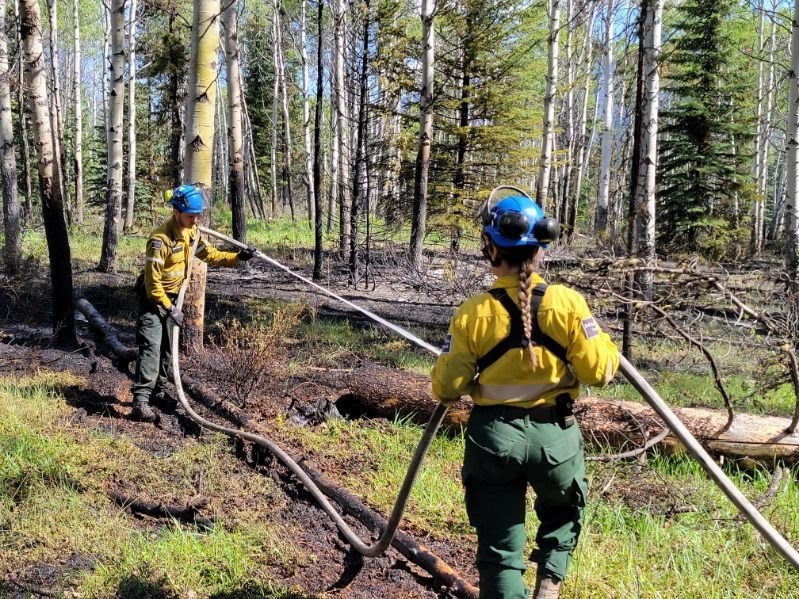There were 15 wildfires that were recorded in the park, a fairly normal count by resource conservation manager Dave Argument’s estimation.
“That's not out of the ordinary. We often have a surprising number of very small starts. That was consistent with this year. Of those 15 wildfires, only three of them grew to more than half a hectare in size, which is pretty good.”
The largest wildfire event was the Corral Creek Wildfire, which grew to 2.4 ha. The site is located approximately 20 km northeast of the Jasper townsite along the Athabasca River.
Caused by lightning, the wildfire took 10 fire personnel and one helicopter before it was extinguished on September 4, only three days after its ignition.
It started on the one-year anniversary of the Chetamon Wildfire, the most notable wildfire by far from 2022.
That wildfire event, also caused by lightning, grew to approximately 6,450 ha and took more than 100 crew members and up to five helicopters several months before it was deemed to be under control.
Smouldering was still visible in one area of the wildfire’s perimeter in mid-March, six months after it started.
“That's the largest wildfire we've had in recent history in Jasper,” Argument said.
“But this year, we were lucky in the spring. In spite of an early start to the fire season throughout most of Alberta, we took enough precipitation in the spring and into the year reasonably well.”
Jasper National Park received just enough precipitation throughout the spring and summer to keep the fire danger predominantly at a “low” to “moderate” level for the bulk of the season.
One positive outcome of this was how it meant that local wildfire fighting team members could be deployed to assist at other locations.
The Jasper Field Unit sent 14 fire specialists and an additional 17 trained firefighters to support emergency incidents across Western Canada.
Many local team members were sent on multiple deployments to northern Alberta and the Northwest Territories from early May until mid-October.
Four of 2023’s other wildfires of note in Jasper National Park were at Snaring Overflow (0.2 ha in size; likely started by industrial activities), Portal Creek (1.7 ha in size; likely started by a bear cub that was electrocuted after making climbing a power pole), Minaga Creek (0.6 ha in size; caused by lightning), and Chaba Creek (1.5 ha in size; caused by lightning).
Prompt reports of smoke made by members of the public helped the Wildfire Management Team to detect these wildfires earlier, leading to them being suppressed faster.
Overall, Canada’s national parks had a miserable year as 1,013,000 ha were burned within Parks Canada’s protected areas.
This total surpassed the previous record when 747,500 ha were burned in 1981.
Last year’s wildfires burned faster and lasted longer than was reportedly anticipated by climate experts.
In response to the unprecedented wildfire season of 2023, Jasper National Park contributed 14 fire specialists and an additional 17 trained firefighters to support emergency incidents across Western Canada.
Many Jasper National Park team members went on multiple deployments to northern Alberta and the Northwest Territories from the beginning of May until the middle of October.
According to Natural Resources Canada, wildfires burned a staggering 16.5 million ha of land across the country, which bested the previous record in 1989.
Even though winter is typically considered to be wildfire’s off-season, a wildfire could still happen.
There is a very low amount of snow on the ground and not much precipitation is expected within the next week.
Environment and Climate Change Canada recently announced that it anticipated higher-than-normal temperatures throughout the country this season as El Niño conditions were expected to continue.
Last year was the hottest year in recorded human history, it indicated in a press release.
Argument said this was why wildfire fighting never rests.
“We're spending the winter planning and preparing for another coming fire year because, of course, it’ll be on us before we know it. We’re concerned about the amount of snow and moisture that we're receiving so far this winter.”
Crew members are busy working on wildfire risk reduction work, refreshing the community fire guard and conducting much brushpile burning in preparation for the 2024 wildfire season.




